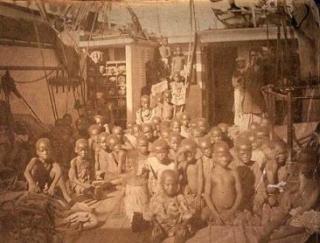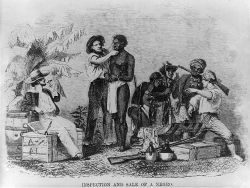
Exploring the history and experiences of mixed heritage persons and inter-racial relationships across the world

Exploring the history and experiences of mixed heritage persons and inter-racial relationships across the world
Slavery has existed at least from the time humans started to settle down and give up the 'hunt and gather' society. For an interesting look at slavery without the hype see http://en.wikipedia.org/wiki/Slavery and http://en.wikipedia.org/wiki/Slave_trade.
The slavery being discussed in this article is the transatlantic trade between the 16th and the 19th centuries. Whilst there are some effects of other slave trading periods visible today, for example, the the Siddis in India and the Sheedis of Pakistan who are believed to be the descendants of slaves, sailors and servants and from East Africa , it is the scale of the transatlantic trade that has really left its mark. Estimates cover a wide range but most will agree that at least 10 million people where moved during this period and the cost in lost lives also numbered in the millions. Considering the population of the world and of Africa in particular at that time, it will be a gross under exaggeration to say its effect then was minimum. Even today, the forced immigration of 10 million people from one region would have a destabilizing effect.
 The Portuguese with their early trading settlements along the West African coast took full advantage of their position and shipped numerous slaves to Brazil to replace the local natives, the tuppis, who were dying in their thousands from the Old world diseases like smallpox. The Spanish, the other great explorers, on the other hand did not play a large part in the slave trade itself but granted the license to trade enslaved people to their colonies which in the early part of the period was mainly Portuguese traders. The Spanish though have the dubious reputation of being the first of the colonisers to use African Slaves in the Western hemisphere in Cuba and Hispaniola - Haiti and The Dominican Republic.
The Portuguese with their early trading settlements along the West African coast took full advantage of their position and shipped numerous slaves to Brazil to replace the local natives, the tuppis, who were dying in their thousands from the Old world diseases like smallpox. The Spanish, the other great explorers, on the other hand did not play a large part in the slave trade itself but granted the license to trade enslaved people to their colonies which in the early part of the period was mainly Portuguese traders. The Spanish though have the dubious reputation of being the first of the colonisers to use African Slaves in the Western hemisphere in Cuba and Hispaniola - Haiti and The Dominican Republic.
The British with their prized positions in the West Indies and North America where the next biggest slavers followed by the French. Not much of the Dutch wealth is said not have been related to the slave trade but she was the center of the trade for a number of her European traders, apparently having some 16,000 slave ships registered there. Of course the North Americans count as another slaving nation playing a larger part in the 18th century when about 50% of the total of slaves ever transported was.
The results of these three centuries are so obvious today all over the Americas. In some places the descendants of these slaves appear to even have replaced/totally absorbed the Native populations, if ever there was one. In others like the North of Brazil, it is more likely there was inter-breeding between the major racial divides with the Natives and the Slaves and the Slave Masters probably intermixing over a number of generations. The African influence in North Brazil is said to be noticeable so slavery's footprint is nowhere near being erased.
It is noticeable that the Central and South American Spanish colonies do not have as pronounced effect as the other colonisers. This may be due to a number of factors, the lack of direct role in slaving, the willingness to use Natives for mainly for mining as opposed to high labour plantations and that most of their territories were on the west coast of the Americas, Argentina presents a fascinating deviation from the rest of the Spanish Americas.
Whilst there are some slave descendants, like the Maroons who claim to be direct descendants of runaway slaves, many of these people particular in the USA who would have not admit to having some interracial mix in their family tree. The TV series Roots is recommended watching if you have not watched it. The Maroons were known on some islands to have interbred with Native people so it is likely that they are not a pure genetic line back to Africa.
 In the West Indies and in the States, the offspring of white masters and slaves tended to be treated a little differently form the other slaves, usually talking the role of house slave - cooking and housekeeping as opposed to field labour. However, in the USA at least, there was a tendency towards breeding back into the slave population that meant that a separate 'mixed' community did not form after slavery was abolished. Eventually the African-American mix was and still is regarded as a black race rather than a mixed race.
In the West Indies and in the States, the offspring of white masters and slaves tended to be treated a little differently form the other slaves, usually talking the role of house slave - cooking and housekeeping as opposed to field labour. However, in the USA at least, there was a tendency towards breeding back into the slave population that meant that a separate 'mixed' community did not form after slavery was abolished. Eventually the African-American mix was and still is regarded as a black race rather than a mixed race.
In the USA today, the offspring of an African American mix with another race, white, Latino or others is what is regarded as mixed heritage. Many Americans still hold onto the 'one drop' rule and refuse to acknowledge a separate mixed race identity. Mixed Heritage people are now the fastest growing section of the American population.
In the West Indies, the story is a little different with some lines of mixed heritage families still evident in some places and in some places, like the Dominican Republic, most people regard themselves of mixed heritage.
The abolition of slavery and the losses of colonies in the Americas made many Western powers look elsewhere for economic power and Asia and Africa were the places to do it.